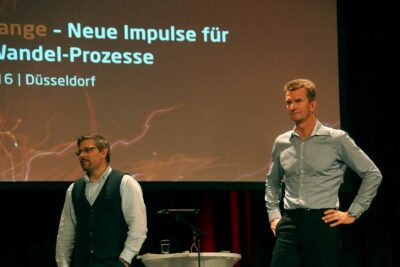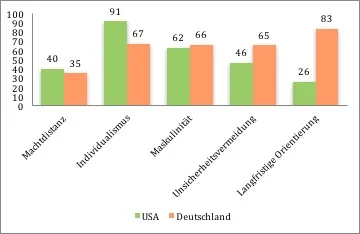Leadership and Management Germany
Leadership and Management in Germany.
Leadership – Communication – Culture
For Germans, things and facts are more important than interpersonal relationships. Using first names is not as common as in England or France, their body language is controlled and doors usually remain closed. Structure in all matters, order and performance are reflected in most areas. These characteristics belong as well to leadership and management in Germany.

A characteristic associated with German culture by many foreigners is thoroughness. In fact, this characteristic appears to have a strong influence on the attitudes and behavior patterns of employees as well as the leadership style of managers. The Germans also stand out in terms of other cultural dimensions. Conclusions can also be drawn from this regarding the effectiveness leadership instruments originated in the USA such as Management by Objectives on leadership and management in Germany.
Traditional values and notions of leadership.
 Speaking of the Germans, people from many countries think of the expression "German thoroughness" or at least a similar image. As in other cultures, the ingredients of German thoroughness shape their attitudes and behavior patterns as well as their leadership style.
Speaking of the Germans, people from many countries think of the expression "German thoroughness" or at least a similar image. As in other cultures, the ingredients of German thoroughness shape their attitudes and behavior patterns as well as their leadership style.
values and behavior patterns
For the Germans, things are more important than interpersonal relationships. They don't find it easy to use first names, their body language is controlled and doors mostly stay closed. Structure in all matters, order and performance is reflected in all areas. From her perspective, her direct communication style is an expression of honesty, openness, authenticity and clarity. Not saying what you think, on the other hand, seems dishonest to them.
 The Germans are very high on the monochronic scale. This means that the tasks are carried out strictly according to plan. Decisions are made in a consensus-oriented manner based on thorough research processes. This feature makes them slow and complicated in the eyes of the Americans and French. Once decisions have been made, they are considered untouchable. Those affected stand behind it. Questioning decisions after they have been made in the team is considered arbitrary and irresponsible in German culture. Discipline and thoroughness are very important. The past is deeply imprinted in their consciousness, writes the American anthropologist Edward T. Hall. So they will go far in the communication and provide many details to explain the current state of affairs. Businesses are long term with thorough planning (Hall, 1990).
The Germans are very high on the monochronic scale. This means that the tasks are carried out strictly according to plan. Decisions are made in a consensus-oriented manner based on thorough research processes. This feature makes them slow and complicated in the eyes of the Americans and French. Once decisions have been made, they are considered untouchable. Those affected stand behind it. Questioning decisions after they have been made in the team is considered arbitrary and irresponsible in German culture. Discipline and thoroughness are very important. The past is deeply imprinted in their consciousness, writes the American anthropologist Edward T. Hall. So they will go far in the communication and provide many details to explain the current state of affairs. Businesses are long term with thorough planning (Hall, 1990).
Communication
In contrast to the French, according to Hall, the Germans are a low-context and monochronic society. In fact, the Germans provide all the information that their interlocutors consider necessary. For some high-context cultures, it can be overwhelming. The table below compares the German and American approaches to project management and illustrates, on the one hand, the above-mentioned cultural dimensions of the Germans and, on the other hand, strongly divergent attitudes and behavioral patterns between the two cultures.
| German approach | US action |
| Holistic coverage of the problem: Informationssammlung, theoretische Erörterung der Umsetzung, Orientierung am technisch machbaren. |
Specification of the result: brainstorming, precise description of the end result, orientation towards the future user/buyer. |
| Consensus orientation: Agreement on the final result and a common solution strategy, taking on individual tasks on your own responsibility. |
Action Orientation: Quick definition of interim results, team leader assigns subtasks, individual result-oriented processing |
| Intensive planning: In the event of complications, no individual changes to the planned procedure, but renewed joint planning. |
Trial-Error Principle: Individual testing of solution strategies, willing change of intermediate or final goals in the event of complications. |
| Organized information exchange: When working through jointly planned subtasks, spontaneous exchanges between planned meetings are perceived as disruptive. |
Spontaneous exchange of information: Rapidly changing information situation requires spontaneous exchange of information, need for frequent feedback on work done. |
German and American approaches in projects (based on Wastian, Braumandl, von Rosenstiel, 2012, p. 314)
This comparison makes clear the characteristics of German culture mentioned in the previous chapter, namely the strong formalism, monochronism and the tendency to see decisions as set in stone. These characteristics of German culture can be seen in the Hofstede culture dimension “uncertainty avoidance”, which is also compared to the American dimensions in the next paragraph appear extreme to each other. The individualism index is very high among Americans, but the corresponding German value also underlines a high level of individualism. The difference in uncertainty avoidance shows that Americans are in the bottom half and Americans are well in the top half.
Leadership and Management Germany - Management style.
The different values in the cultural dimensions of both countries can be seen in the communication, in the project approach or in the use of management tools. According to Hofstede, the Germans are not classic “customers” for management by objective because of their high level of avoidance of uncertainty. In this regard he writes " This is also a below-average PDI (Power Distance Index) country, so the dialogue element in MbO should present no problem. However, Germany scores considerably higher on UAI (Uncertainty Avoidance Index); Consequently, the acceptance of ambiguity is weaker. MbO in Germany has been strongly formalized and converted into "management by joint goal setting" (Hofstede, 2010, p. 335). to recognize. According to Hofstede, the Germans are not classic “customers” for management by objective because of their high level of avoidance of uncertainty. In this regard he writes " This is also a below-average PDI (Power Distance Index) country, so the dialogue element in MbO should present no problem. However, Germany scores considerably higher on UAI (Uncertainty Avoidance Index); Consequently, the acceptance of ambiguity is weaker. MbO in Germany has been strongly formalized and converted into "management by joint goal setting" (Hofstede, 2010, p. 335).
Management by Objectives (MbO) in Germany and cultural dimensions
Studies on the MbO in Germany and in Switzerland
In 2010, the study by the German consulting firm Saaman AG (https://www.saaman.de) was devoted to the topic of “Effectiveness of target agreements” (in German). The following is recorded:
“The target agreements are misused to determine what the individual has to do. Above all, executives fear chaos because an instrument for assigning tasks would be eliminated. It is astonishing when one sees at the same time that the original purpose of the target agreements, which was to increase motivation (17%) and encourage better performance (6%), is less missed by managers in comparison. So the question arises as to whether the instrument is not being systematically misused here”. This comment refers to question number 14 of a questionnaire filled out by executives and employees of numerous German companies.
The question is: "What do you think would happen in your company if there were no target agreements tomorrow?". 37% of managers and only 19% of employees underlined "disorientation/loss of control" as an answer. Conversely, 35% of employees and only 19% of managers indicated "no or only minor effects" (Saaman AG, 2011, p. 19).
The summarizing comment of the consulting firm confirms, at least in the case of many executives, the urge to avoid uncertainty, in which executives achieve the formalization sought in German culture by using the MbO. However, to a large extent, employees have different opinions than managers. With the 20% who see the abolition of target agreements as an improvement, 55% of employees have a negative attitude towards the MbO. It is not surprising that the study draws conclusions from these results such as: "Target agreements are a farce, an elaborate spectacle Target agreements have the appearance of being non-binding and are therefore becoming an administratively necessary evil in many companies (Saaman AG, 2010, p. 7 - 14 )”. The fact that most German companies determine and evaluate the target agreements in an annual cycle increases the ambiguity of the procedure in view of the rapid changes in the environment. The Saaman study states in this regard: “Periods of 1 year show that target agreements in most companies do not correlate with what is actually happening in the economy. Habit overrides necessity. Over a long period of time, performance is influenced by numerous external factors that would have to be incorporated into updated target agreements if the instrument were to continue to prove effective. It is therefore not surprising that many of the respondents are formally held responsible, but in case of doubt they quickly evade responsibility by referring to external circumstances” (Saaman AG, 2010, p. 5).
In Switzerland, a similar study was published in 2016 by Intermedio, which delivered similar results. The study entitled “Is leadership through agreed objectives still relevant?” is available to download here.
Recommendations for the design of the MbO process
The natural urge of Germans to plan long-term and in detail is in contradiction to an MbO process that cannot run with the precision of clockwork. A certain flexibility and the acceptance of a certain amount of ambiguity are necessary to use the MbO effectively. Especially in a fast-moving time, these qualities are in demand more than ever. However, non-German superiors should at least take into account the attitude and expectations of German employees to a reasonable degree, or, if necessary, address strongly divergent attitudes between employees and superiors.

